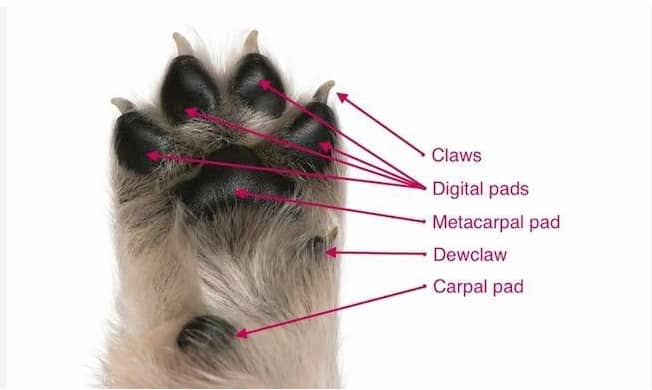In the realm of zoology, the intricate anatomical features of animals often spark curiosity and contribute to our understanding of evolutionary adaptations. One such subject that has piqued interest is the number of toes on a dog’s paws.
The juxtaposition of simplicity and complexity arises when considering this seemingly straightforward question.How many toes does a dog have? While humans possess five digits on each extremity, dogs exhibit a diverse range in their toe count.
This article aims to explore the anatomy of a dog’s paw and delve into the variations in toe numbers observed among different breeds. Additionally, it will investigate potential evolutionary reasons behind these variations, shedding light on how dogs’ feet have adapted over time for various functions.
Through an objective examination of scientific research and factual observations, this article seeks to provide readers with a comprehensive overview of how many toes dogs possess and the significance behind these structural variations.

Key Takeaways
- Dogs have a diverse range of toe counts compared to humans.
- Dogs typically have five toes on their front paws and four toes on their hind paws.
- The number and arrangement of toes vary within different dog breeds.
- The toe structure of dogs plays a vital role in their locomotion, agility, and overall health.
The Anatomy of a Dog’s Paw
The anatomy of a dog’s paw includes multiple components, such as the metacarpal and phalangeal bones, which collectively support the dog’s toes.
The dog paw structure is designed to provide stability and mobility for the animal. The metacarpal bones connect the carpal bones of the forelimb to the phalanges, while the phalangeal bones make up the individual digits or toes.

Each toe consists of several small bones connected by joints, allowing for flexibility and dexterity. Additionally, each toe is covered by a paw pad which serves as a protective cushion during locomotion.
Paw pads have unique characteristics that vary between dog breeds and can contribute to their overall ability to grip surfaces and withstand different terrains.
Understanding the intricate anatomy of a dog’s paw is crucial for veterinarians and pet owners alike in order to ensure proper care and maintenance of this essential body part.
The Number of Toes on a Dog’s Front Paws
Counting the digits on a canine’s forelimbs reveals the exact number of phalanges present. Dogs typically have five toes on their front paws, each equipped with a claw. The number of claws corresponds to the number of toes, and they play an important role in a dog’s daily activities. These claws are used for gripping various surfaces and aiding in balance while walking or running.

Additionally, they assist dogs in digging and scratching as part of their natural behaviors. Alongside the claws, the paw pad structure also contributes to a dog’s mobility and stability. Paw pads provide cushioning and protection during movement, allowing dogs to traverse different terrains without discomfort or injury.
Understanding the number of toes and their associated functions aids in appreciating the intricate anatomy that enables canines to navigate their surroundings efficiently.
The Number of Toes on a Dog’s Hind Paws
The arrangement of digits on a canine’s hind paws provides crucial biomechanical advantages during locomotion and contributes to their overall agility and stability. Dogs typically have four toes on their hind paws, commonly referred to as the “toe beans” by enthusiasts.
Each toe is equipped with a claw that aids in gripping various surfaces, enhancing traction and preventing slips. This evolutionary significance can be attributed to the need for dogs to maintain balance while running, jumping, or traversing different terrains. The placement of these toes allows for a wider weight distribution across the foot, increasing stability and reducing the risk of injury.
Furthermore, this digit arrangement enables dogs to make quick turns and changes in direction with ease, further highlighting their remarkable agility. Overall, the number and positioning of toes on a dog’s hind paws play a vital role in their locomotion abilities and contribute significantly to their overall physical prowess.
| Toe | Claw Present |
|---|---|
| 1 | Yes |
| 2 | Yes |
| 3 | Yes |
| 4 | Yes |
Note: Claw presence indicates whether or not each toe has a claw attached.
Evolutionary Reasons for How Many Toes Does A Dog Have
Evolutionary factors have influenced the number of toes in canines’ hind paws, resulting in a specific arrangement that enhances their locomotive capabilities. The evolution of dogs from their wolf ancestors has led to certain adaptations that provide them with evolutionary advantages in various environments.

One such adaptation mechanism is the reduction in the number of toes on their hind paws. Canines typically have four toes on their hind limbs, which are strategically positioned to optimize balance and agility during movement.
The evolutionary advantages of having four toes lie in the improved weight distribution and stability they offer. This arrangement allows for efficient running, jumping, and maneuvering through different terrains. The reduced number of toes also decreases the surface area in contact with the ground, reducing friction and enhancing speed.
Overall, the evolution of canines’ hind paw structure demonstrates how adaptation mechanisms can shape anatomical features to maximize locomotive efficiency. Through selective pressures and natural selection over time, dogs have evolved a specific toe arrangement that provides them with distinct advantages for survival and mobility.
Fun Facts About Dog’s Toes
Did you know that the intricate webbing between a dog’s toes helps them with their balance and stability while navigating various terrains? This unique toe structure enables dogs to distribute their weight evenly, preventing slips and falls. Additionally, the webbing acts as a shock absorber, reducing the impact on their joints when running or jumping.
Fun facts about dog’s toes:
- Dog paw print patterns are like fingerprints for humans; they are unique to each individual dog.
- Dogs have dewclaws, which are small, non-functional toes located higher up on their legs.
- Some dogs have double dewclaws on their hind legs, which provide added grip when climbing or descending steep areas.
- Certain breeds of dogs have more toes than others. For example, Great Pyrenees and Saint Bernards often have six toes on their hind feet.
- The number and arrangement of toes can vary within different dog breeds, showcasing the incredible diversity in canine anatomy.
Overall, understanding the fascinating aspects of a dog’s toe structure enhances our appreciation for these loyal companions and underscores the importance of providing them with proper care to maintain optimal health and mobility.
See Also:
- How To Stop Dogs Digging Behavior
- Why My Dog Follow Me
- Do Dogs Get Headaches? Signs, Causes, and Best Treatments
- Can Dogs Get Hemorrhoids: Symptoms, Causes, & Treatment
- Dog Weight Calculator
- Can Dogs Get Pimples
- Do Dogs Like Music
- Why Is My Dog Sneezing So Much
Conclusion
In conclusion, understanding the anatomy of a dog’s paw reveals the number of toes they possess. While front paws typically have five toes, hind paws generally have four. This variation can be attributed to evolutionary reasons, as dogs’ ancestors adapted for efficient movement and balance.
Interestingly, dog’s toes serve various purposes such as gripping surfaces and providing stability during running or climbing. These unique features make dogs remarkable creatures with fascinating toe-related facts to explore.
“If you can’t find the right dog for you to adopt locally, please consider adopting a dog from Bone Voyage Dog Rescue. We’ll fly with your dog to you.”
Frequently Asked Questions
Can dogs have extra toes or fewer toes than the average number?
Dogs can have extra or fewer toes due to genetic mutations. These mutations may result in polydactyly, a condition where dogs have more than the normal number of toes, or oligodactyly, where they have fewer toes.
Do all dog breeds have the same number of toes?
Not all dog breeds have the same number of toes. Some dogs can have extra toes or fewer toes than the average number. This variation in toe count is a result of genetic factors and breed characteristics.
Are a dog’s front paws and hind paws structured differently in terms of the number of toes?
Front paw anatomy and hind paw anatomy in dogs are structured differently in terms of the number of toes. The front paws typically have five toes, while the hind paws usually have four toes.
Are there any health conditions or abnormalities related to the number of toes in dogs?
Health conditions related to toe abnormalities in dogs can have a significant impact on their mobility and quality of life. These abnormalities can include polydactyly, brachydactyly, and syndactyly, which can lead to difficulties in walking, running, and performing daily activities.
Are there any specific breeds known for having a higher or lower number of toes?
Certain dog breeds, such as the Norwegian Lundehund and the American Eskimo Dog, are known to have extra toes. While this may not significantly impact their mobility, it is important to consider potential complications that could arise from having additional digits.
